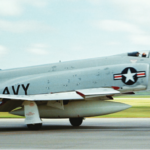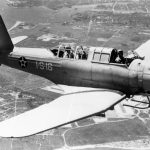Today marks the 68th anniversary of the Lockheed YC-130’s maiden flight. While some may not consider the mighty Hercules a ‘warbird’ yet (the type is still in production and operating in large numbers with air arms around the world – including the United States) there are numerous former military examples presently in civilian service as well. And this clearly fits the commonly accepted definition for that awkward term ‘warbird’. Starting in 1964, the type was also manufactured for direct civilian sale as the Lockheed L-100 as well, with some of those early examples still soldiering on today too – so one could even argue that the Hercules has classic civil roots as well. Given the type’s importance, longevity, ubiquity, and diversity of use, one might even say the Hercules is the super-sized C-47 of the modern era. It is certainly one of the most important aircraft designs ever built…
Today In Aviation History: First Flight of The Lockheed YC-130 Hercules
by Bryan R. Swopes of This Day in Aviation
On August 23, 1954, the first of two Lockheed YC-130 Hercules (s/n 53-3397) four-engine transport prototypes, made its first flight from the Lockheed Air Terminal at Burbank, California, to Edwards Air Force Base. The flight crew consisted of test pilots Stanley Beltz and Roy Wimmer, with Jack G. Real (a future Lockheed vice president) and Dick Stanton as flight engineers. From a standing start, the YC-130 was airborne at 855 feet (261 meters), The flight lasted 1 hour and 1 minute.
The C-130 was designed as basic tactical transport, capable of carrying 72 soldiers or 64 paratroopers. All production aircraft have been built at Lockheed Martin’s Marietta, Georgia, plant.
The first production model, the C-130A Hercules, was 97.8 feet (29.81 meters) long with a wingspan of 132.6 feet (40.42 meters), and a height of 38.1 feet (11.61 meters). The total wing area was 1,745.5 square feet (162.16 square meters). The transport’s empty weight was 59,164 pounds (26,836 kilograms) and its takeoff weight, was 122,245 pounds (55,449 kilograms).
The C 130 has a rear loading ramp for vehicles, and there is a large cargo door on the left side of the fuselage, forward of the wing, The transport’s cargo compartment volume is 3,708 cubic feet (105.0 cubic meters). It could carry 35,000 pounds (15,876 kilograms) of cargo.
The C-130A was equipped with four Allison T56-A-1A turboshaft engines, driving three-bladed propellers. The engines produced 3,094 shaft horsepower at 13,820 r.p.m. (continuous), and 3,460 horsepower, Military Power (30-minute limit) or Takeoff ( 5-minute limit).
The C-130A had a cruise speed of 286 knots (329 miles per hour/530 kilometers per hour) and a maximum speed of 326 knots (375 miles per hour/604 kilometers per hour) at 24,200 feet (7,376 meters). Its range with a 35,000 pound ( kilogram) payload was 1,835 nautical miles (2,112 statute miles/3,398 kilometers). The initial rate of climb at Sea Level was 4,320 feet per minute (21.95 meters per second). The combat ceiling was 38,700 feet (11,796 meters).
In addition to its basic role as a transport, the C-130 has also been used as an aerial tanker, a command-and-control aircraft, weather reconnaissance, search and rescue, and tactical gunship. It has even been used as a bomber, carrying huge “Daisy Cutters” to clear large areas of the jungle for use as helicopter landing zones, or, more recently, the Massive Ordnance Air Blast “mother of all bombs.” The aircraft has been so versatile that it has served in every type of mission. Over 40 variants have been built by Lockheed, including civilian transports. It is in service worldwide.
The latest version is the Lockheed C-130J Hercules. After 68 years, the C-130 is still in production, longer than any other aircraft type. YC-130 53-3397 was scrapped at Indianapolis in 1962.



































